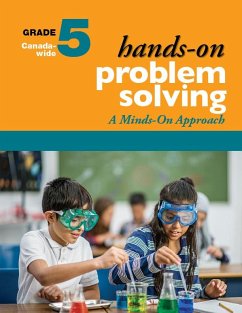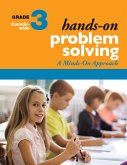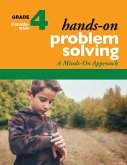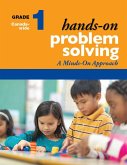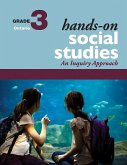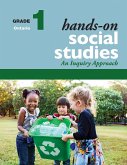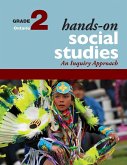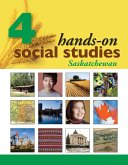- Broschiertes Buch
- Merkliste
- Auf die Merkliste
- Bewerten Bewerten
- Teilen
- Produkt teilen
- Produkterinnerung
- Produkterinnerung
Hands-On Problem Solving is essential to learning mathematics. When actively engaged in problem solving, students use all the mathematical processes they need in order to achieve the goals of mathematics education and to support lifelong learning. In Hands-On Problem Solving, students are exposed to a wide range of problems in all areas of mathematics. They solve these problems by applying a combination of mathematical knowledge, tools, and strategies. They also explore a variety of methods for solving and confirming their solutions. The ability to use mathematical knowledge to solve problems…mehr
Andere Kunden interessierten sich auch für
![Hands-On Problem Solving, Grade 3 Hands-On Problem Solving, Grade 3]() Jennifer E LawsonHands-On Problem Solving, Grade 388,99 €
Jennifer E LawsonHands-On Problem Solving, Grade 388,99 €![Hands-On Problem Solving, Grade 4 Hands-On Problem Solving, Grade 4]() Jennifer E LawsonHands-On Problem Solving, Grade 488,99 €
Jennifer E LawsonHands-On Problem Solving, Grade 488,99 €![Hands-On Problem Solving, Grade 1 Hands-On Problem Solving, Grade 1]() Jennifer E LawsonHands-On Problem Solving, Grade 188,99 €
Jennifer E LawsonHands-On Problem Solving, Grade 188,99 €![Hands-On Social Studies for Ontario, Grade 3 Hands-On Social Studies for Ontario, Grade 3]() Jennifer E LawsonHands-On Social Studies for Ontario, Grade 3123,99 €
Jennifer E LawsonHands-On Social Studies for Ontario, Grade 3123,99 €![Hands-On Social Studies for Ontario, Grade 1 Hands-On Social Studies for Ontario, Grade 1]() Jennifer E LawsonHands-On Social Studies for Ontario, Grade 1122,99 €
Jennifer E LawsonHands-On Social Studies for Ontario, Grade 1122,99 €![Hands-On Social Studies for Ontario, Grade 2 Hands-On Social Studies for Ontario, Grade 2]() Jennifer E LawsonHands-On Social Studies for Ontario, Grade 2123,99 €
Jennifer E LawsonHands-On Social Studies for Ontario, Grade 2123,99 €![Hands-On Social Studies for Saskatchewan, Grade 4 Hands-On Social Studies for Saskatchewan, Grade 4]() Jennifer E LawsonHands-On Social Studies for Saskatchewan, Grade 4116,99 €
Jennifer E LawsonHands-On Social Studies for Saskatchewan, Grade 4116,99 €-
-
-
Hands-On Problem Solving is essential to learning mathematics. When actively engaged in problem solving, students use all the mathematical processes they need in order to achieve the goals of mathematics education and to support lifelong learning. In Hands-On Problem Solving, students are exposed to a wide range of problems in all areas of mathematics. They solve these problems by applying a combination of mathematical knowledge, tools, and strategies. They also explore a variety of methods for solving and confirming their solutions. The ability to use mathematical knowledge to solve problems is the goal for all students. Hands-On Problem Solving is an easy-to-use resource that helps teachers plan and implement best practices to meet this goal. In this book, you will find * problem-solving activities to incorporate into daily mathematics classes for an entire school year * a correlation chart identifying the math concepts presented in each lesson * tasks designed for specific outcomes and learning expectations from Canadian curriculum documents * problems integrating other curricular areas such as language arts, science, and social studies * materials lists, reproducibles, assessment suggestions, and much more! Download the FREE digital resources that accompany this book by following the instructions printed on the first page of the Appendix.
Hinweis: Dieser Artikel kann nur an eine deutsche Lieferadresse ausgeliefert werden.
Hinweis: Dieser Artikel kann nur an eine deutsche Lieferadresse ausgeliefert werden.
Produktdetails
- Produktdetails
- Verlag: Portage & Main Press
- Canada-Wide edition
- Seitenzahl: 264
- Altersempfehlung: ab 5 Jahre
- Erscheinungstermin: 26. Juni 2013
- Englisch
- Abmessung: 262mm x 218mm x 18mm
- Gewicht: 748g
- ISBN-13: 9781553793632
- ISBN-10: 1553793633
- Artikelnr.: 55875944
- Herstellerkennzeichnung
- Libri GmbH
- Europaallee 1
- 36244 Bad Hersfeld
- gpsr@libri.de
- Verlag: Portage & Main Press
- Canada-Wide edition
- Seitenzahl: 264
- Altersempfehlung: ab 5 Jahre
- Erscheinungstermin: 26. Juni 2013
- Englisch
- Abmessung: 262mm x 218mm x 18mm
- Gewicht: 748g
- ISBN-13: 9781553793632
- ISBN-10: 1553793633
- Artikelnr.: 55875944
- Herstellerkennzeichnung
- Libri GmbH
- Europaallee 1
- 36244 Bad Hersfeld
- gpsr@libri.de
Jennifer E. Lawson, PhD, is the creator of the Hands-On books published by Portage & Main Press. As senior writer and editor for the series, she has contributed to more than 50 publications for teachers and students. Jennifer provides professional development workshops for educators locally, nationally, and virtually, and is a Workplace Wellness Advisor. Her most recent book is a collective effort called Teacher, Take Care: A Guide to Well-Being and Workplace Wellness for Educators. She is also one of the founders of Mission to Mexico, an organization that supports schools in some of the most impoverished communities in Puerto Vallarta. Throughout her extensive career in education, Jennifer has worked as a classroom teacher, resource and special education teacher, consultant, principal, university instructor, and school trustee. She lives with her family in Winnipeg, Manitoba.
Introduction to Hands-On Problem Solving, Grade 5 1
* Program Introduction 2
* Program Principles 2
* Big Ideas in Mathematics 2
* Communication 2
* Connections 3
* Mental Math 3
* Estimation 3
* Reasoning 4
* Technology 4
* Visualization 4
* Problem Solving 4
* What Is Problem Solving? 4
* Best Practices in Teaching
* Problem Solving 5
* Routine Problems 5
* Non-Routine Problems 5
* Extended Exploration Problems 7
* Implementing the Hands-On
* Problem-Solving Program 7
* Program Format 7
* Planning Your Year of Problem Solving 7
* Curricular Connections 8
* Supporting Literacy During Problem
* Solving 8
* The Questioning Process 8
* Additional Resources 8
* A Note About Pennies 8
* Guiding and Supporting Learning:
* Problem Solving 10
* Mathematics Correlation 11
* Grade 5 Correlation Chart 11
The Hands-On Problem Solving Assessment Plan 13
* Assessment for Learning 13
* Assessment as Learning 13
* Assessment of Learning 14
* Performance Assessment 14
* Portfolios 14
* Assessment Reproducibles 15
Routine Problems 23
1. Implementation of Routine Problems 24
2. Problem Types 24
3. Teaching Routine Problems 25
* 1A The Super-Duper Six-Dice Game 30
* 2A Estimating the Number of Seeds 33
* 3A Debating Groups 36
* 4A Stacking Loonies 38
* 5A Pelican Eggs 41
* 6A If Colin Filled Five Albums 44
* 7A Collecting Money 46
* 8A Paddling Puzzler 48
* 9A Youngest to Oldest 50
* 10A Evaporating Water 52
* 11A Picking Blueberries 54
* 12A One Million Eggs 56
* 13A Lilac Bush Buds 58
* 14A Building a Sandbag Dike 60
* 15A Replacing Boards on the Boardwalk 62
* 16A Gestation Period: Humans vs. Rabbits 64
* 17A Playground Perimeter 67
* 18A Don’t Forget the Sunblock! 69
* 19A Running Long-Jump Total 72
* 20A How Many Mosquitoes? 74
* 21A Spiders Weigh-In 76
* 22A Chocolate Brownies 78
* 23A Many Grains of Rice 80
* 24A Mr. Mekanic’s Alphabet Patterns 83
* 25A What Did He Say? 85
* 26A The “Run for Heart Health” Race 87
* 27A Yan’s Rectangular Chicken Coop 89
* 28A Spray Painting a Graffiti Wall 91
* 29A Knit-Wit Scarves 93
* 30A Geocaching 95
* 31A Buying an Aquarium Pump 97
* 32A Building a Birdhouse 100
* 33A Painting the Pool 102
* 34A Smoking the Beehives 104
* 35A Shapes With Parallel Lines 106
* 36A Reflected Image 108
* 37A Shapes in the Sand 111
* 38A Two Weeks of Physical Activity 115
* 39A Bouncing Balls 120
* 40A Heads or Tails? 122
Non-Routine Problems 125
4. Implementation of Non-Routine Problems 126
5. Teaching Non-Routine Problems 129
6. An Additional Resource for Solving Non-Routine Problems 131
7. Guiding and Supporting Learning: Non-Routine Problems 132
* 1B Venetian Blind Riddle 133
* 2B How Many Handshakes? 135
* 3B The Order of the Coins 137
* 4B The Sequence of Shapes on
* the String 140
* 5B Multiplication Patterns With 36
* as a Factor 142
* 6B Let’s Make a Comic-Book Deal 145
* 7B Who Rides Which Bus? 147
* 8B One of These Nets is Not Like
* the Others 149
* 9B Number Sentence Challenge 151
* 10B Individual Point Scores 154
* 11B The Best Cellphone Plan 156
* 12B Spring Picnic Food Tickets 160
* 13B Rolling Lucky Seven 163
* 14B A Baby’s Mass 166
* 15B Opening Day at the Film Festival 169
* 16B How Many Songs are on Ravi’s
* MP3 Player? 171
* 17B Making Waterproof Sleeping-Bag
* Covers 173
* 18B Making a Slideshow 175
* 19B How Many Fewer Strides? 177
* 20B Seating at Ted’s Bistro 179
* 21B A Cube Number Palindrome 182
* 22B Charm Challenge 184
* 23B Along the Edges of a Cube 186
* 24B Less Than $1 188
* 25B A Total of 41 190
* 26B The Cambridge Falls Canoe Challenge 192
* 27B Sam’s Sister’s Grass-Cutting
* Business 194
* 28B Andy’s Travels 196
* 29B Mr. Banerjee’s Ladder 198
* 30B Jellybean Countdown 200
* 31B Amanda’s Darts Scores 202
* 32B Delivering Surveys 204
* 33B Using Only the Number 5 206
* 34B 1 Through 9 208
* 35B Returning Pennies to the Bank 210
* 36B A Sum of 86 212
* 37B Halloween Costume Combinations 214
* 38B Half of Half of Half... 216
* 39B Edible Mushrooms 218
* 40B Combinations of Support 220
Extended Exploration Problems 223
8. Implementation of Extended Exploration Problems 224
9. Teaching Extended Exploration Problems 224
10. Guiding and Supporting Learning: Extended Exploration Problems 228
* 1C How Many Football Fields? 229
* 2C My Dream Bedroom 232
* 3C Fractions of a Tangram 234
* 4C Estimating the Number of Words on a Page 238
* 5C The Last Chip 240
* 6C Opening Day Giveaways 242
* 7C An Old Record Collection 244
* 8C Jason’s Stained-Glass Design 246
* 9C Jonas’s Five-Layered 3-D Block Structure 248
* 10C Flushing Water Down the Toilet 250
Appendix 253
References 258
About the Authors 259
* Program Introduction 2
* Program Principles 2
* Big Ideas in Mathematics 2
* Communication 2
* Connections 3
* Mental Math 3
* Estimation 3
* Reasoning 4
* Technology 4
* Visualization 4
* Problem Solving 4
* What Is Problem Solving? 4
* Best Practices in Teaching
* Problem Solving 5
* Routine Problems 5
* Non-Routine Problems 5
* Extended Exploration Problems 7
* Implementing the Hands-On
* Problem-Solving Program 7
* Program Format 7
* Planning Your Year of Problem Solving 7
* Curricular Connections 8
* Supporting Literacy During Problem
* Solving 8
* The Questioning Process 8
* Additional Resources 8
* A Note About Pennies 8
* Guiding and Supporting Learning:
* Problem Solving 10
* Mathematics Correlation 11
* Grade 5 Correlation Chart 11
The Hands-On Problem Solving Assessment Plan 13
* Assessment for Learning 13
* Assessment as Learning 13
* Assessment of Learning 14
* Performance Assessment 14
* Portfolios 14
* Assessment Reproducibles 15
Routine Problems 23
1. Implementation of Routine Problems 24
2. Problem Types 24
3. Teaching Routine Problems 25
* 1A The Super-Duper Six-Dice Game 30
* 2A Estimating the Number of Seeds 33
* 3A Debating Groups 36
* 4A Stacking Loonies 38
* 5A Pelican Eggs 41
* 6A If Colin Filled Five Albums 44
* 7A Collecting Money 46
* 8A Paddling Puzzler 48
* 9A Youngest to Oldest 50
* 10A Evaporating Water 52
* 11A Picking Blueberries 54
* 12A One Million Eggs 56
* 13A Lilac Bush Buds 58
* 14A Building a Sandbag Dike 60
* 15A Replacing Boards on the Boardwalk 62
* 16A Gestation Period: Humans vs. Rabbits 64
* 17A Playground Perimeter 67
* 18A Don’t Forget the Sunblock! 69
* 19A Running Long-Jump Total 72
* 20A How Many Mosquitoes? 74
* 21A Spiders Weigh-In 76
* 22A Chocolate Brownies 78
* 23A Many Grains of Rice 80
* 24A Mr. Mekanic’s Alphabet Patterns 83
* 25A What Did He Say? 85
* 26A The “Run for Heart Health” Race 87
* 27A Yan’s Rectangular Chicken Coop 89
* 28A Spray Painting a Graffiti Wall 91
* 29A Knit-Wit Scarves 93
* 30A Geocaching 95
* 31A Buying an Aquarium Pump 97
* 32A Building a Birdhouse 100
* 33A Painting the Pool 102
* 34A Smoking the Beehives 104
* 35A Shapes With Parallel Lines 106
* 36A Reflected Image 108
* 37A Shapes in the Sand 111
* 38A Two Weeks of Physical Activity 115
* 39A Bouncing Balls 120
* 40A Heads or Tails? 122
Non-Routine Problems 125
4. Implementation of Non-Routine Problems 126
5. Teaching Non-Routine Problems 129
6. An Additional Resource for Solving Non-Routine Problems 131
7. Guiding and Supporting Learning: Non-Routine Problems 132
* 1B Venetian Blind Riddle 133
* 2B How Many Handshakes? 135
* 3B The Order of the Coins 137
* 4B The Sequence of Shapes on
* the String 140
* 5B Multiplication Patterns With 36
* as a Factor 142
* 6B Let’s Make a Comic-Book Deal 145
* 7B Who Rides Which Bus? 147
* 8B One of These Nets is Not Like
* the Others 149
* 9B Number Sentence Challenge 151
* 10B Individual Point Scores 154
* 11B The Best Cellphone Plan 156
* 12B Spring Picnic Food Tickets 160
* 13B Rolling Lucky Seven 163
* 14B A Baby’s Mass 166
* 15B Opening Day at the Film Festival 169
* 16B How Many Songs are on Ravi’s
* MP3 Player? 171
* 17B Making Waterproof Sleeping-Bag
* Covers 173
* 18B Making a Slideshow 175
* 19B How Many Fewer Strides? 177
* 20B Seating at Ted’s Bistro 179
* 21B A Cube Number Palindrome 182
* 22B Charm Challenge 184
* 23B Along the Edges of a Cube 186
* 24B Less Than $1 188
* 25B A Total of 41 190
* 26B The Cambridge Falls Canoe Challenge 192
* 27B Sam’s Sister’s Grass-Cutting
* Business 194
* 28B Andy’s Travels 196
* 29B Mr. Banerjee’s Ladder 198
* 30B Jellybean Countdown 200
* 31B Amanda’s Darts Scores 202
* 32B Delivering Surveys 204
* 33B Using Only the Number 5 206
* 34B 1 Through 9 208
* 35B Returning Pennies to the Bank 210
* 36B A Sum of 86 212
* 37B Halloween Costume Combinations 214
* 38B Half of Half of Half... 216
* 39B Edible Mushrooms 218
* 40B Combinations of Support 220
Extended Exploration Problems 223
8. Implementation of Extended Exploration Problems 224
9. Teaching Extended Exploration Problems 224
10. Guiding and Supporting Learning: Extended Exploration Problems 228
* 1C How Many Football Fields? 229
* 2C My Dream Bedroom 232
* 3C Fractions of a Tangram 234
* 4C Estimating the Number of Words on a Page 238
* 5C The Last Chip 240
* 6C Opening Day Giveaways 242
* 7C An Old Record Collection 244
* 8C Jason’s Stained-Glass Design 246
* 9C Jonas’s Five-Layered 3-D Block Structure 248
* 10C Flushing Water Down the Toilet 250
Appendix 253
References 258
About the Authors 259
Introduction to Hands-On Problem Solving, Grade 5 1
* Program Introduction 2
* Program Principles 2
* Big Ideas in Mathematics 2
* Communication 2
* Connections 3
* Mental Math 3
* Estimation 3
* Reasoning 4
* Technology 4
* Visualization 4
* Problem Solving 4
* What Is Problem Solving? 4
* Best Practices in Teaching
* Problem Solving 5
* Routine Problems 5
* Non-Routine Problems 5
* Extended Exploration Problems 7
* Implementing the Hands-On
* Problem-Solving Program 7
* Program Format 7
* Planning Your Year of Problem Solving 7
* Curricular Connections 8
* Supporting Literacy During Problem
* Solving 8
* The Questioning Process 8
* Additional Resources 8
* A Note About Pennies 8
* Guiding and Supporting Learning:
* Problem Solving 10
* Mathematics Correlation 11
* Grade 5 Correlation Chart 11
The Hands-On Problem Solving Assessment Plan 13
* Assessment for Learning 13
* Assessment as Learning 13
* Assessment of Learning 14
* Performance Assessment 14
* Portfolios 14
* Assessment Reproducibles 15
Routine Problems 23
1. Implementation of Routine Problems 24
2. Problem Types 24
3. Teaching Routine Problems 25
* 1A The Super-Duper Six-Dice Game 30
* 2A Estimating the Number of Seeds 33
* 3A Debating Groups 36
* 4A Stacking Loonies 38
* 5A Pelican Eggs 41
* 6A If Colin Filled Five Albums 44
* 7A Collecting Money 46
* 8A Paddling Puzzler 48
* 9A Youngest to Oldest 50
* 10A Evaporating Water 52
* 11A Picking Blueberries 54
* 12A One Million Eggs 56
* 13A Lilac Bush Buds 58
* 14A Building a Sandbag Dike 60
* 15A Replacing Boards on the Boardwalk 62
* 16A Gestation Period: Humans vs. Rabbits 64
* 17A Playground Perimeter 67
* 18A Don’t Forget the Sunblock! 69
* 19A Running Long-Jump Total 72
* 20A How Many Mosquitoes? 74
* 21A Spiders Weigh-In 76
* 22A Chocolate Brownies 78
* 23A Many Grains of Rice 80
* 24A Mr. Mekanic’s Alphabet Patterns 83
* 25A What Did He Say? 85
* 26A The “Run for Heart Health” Race 87
* 27A Yan’s Rectangular Chicken Coop 89
* 28A Spray Painting a Graffiti Wall 91
* 29A Knit-Wit Scarves 93
* 30A Geocaching 95
* 31A Buying an Aquarium Pump 97
* 32A Building a Birdhouse 100
* 33A Painting the Pool 102
* 34A Smoking the Beehives 104
* 35A Shapes With Parallel Lines 106
* 36A Reflected Image 108
* 37A Shapes in the Sand 111
* 38A Two Weeks of Physical Activity 115
* 39A Bouncing Balls 120
* 40A Heads or Tails? 122
Non-Routine Problems 125
4. Implementation of Non-Routine Problems 126
5. Teaching Non-Routine Problems 129
6. An Additional Resource for Solving Non-Routine Problems 131
7. Guiding and Supporting Learning: Non-Routine Problems 132
* 1B Venetian Blind Riddle 133
* 2B How Many Handshakes? 135
* 3B The Order of the Coins 137
* 4B The Sequence of Shapes on
* the String 140
* 5B Multiplication Patterns With 36
* as a Factor 142
* 6B Let’s Make a Comic-Book Deal 145
* 7B Who Rides Which Bus? 147
* 8B One of These Nets is Not Like
* the Others 149
* 9B Number Sentence Challenge 151
* 10B Individual Point Scores 154
* 11B The Best Cellphone Plan 156
* 12B Spring Picnic Food Tickets 160
* 13B Rolling Lucky Seven 163
* 14B A Baby’s Mass 166
* 15B Opening Day at the Film Festival 169
* 16B How Many Songs are on Ravi’s
* MP3 Player? 171
* 17B Making Waterproof Sleeping-Bag
* Covers 173
* 18B Making a Slideshow 175
* 19B How Many Fewer Strides? 177
* 20B Seating at Ted’s Bistro 179
* 21B A Cube Number Palindrome 182
* 22B Charm Challenge 184
* 23B Along the Edges of a Cube 186
* 24B Less Than $1 188
* 25B A Total of 41 190
* 26B The Cambridge Falls Canoe Challenge 192
* 27B Sam’s Sister’s Grass-Cutting
* Business 194
* 28B Andy’s Travels 196
* 29B Mr. Banerjee’s Ladder 198
* 30B Jellybean Countdown 200
* 31B Amanda’s Darts Scores 202
* 32B Delivering Surveys 204
* 33B Using Only the Number 5 206
* 34B 1 Through 9 208
* 35B Returning Pennies to the Bank 210
* 36B A Sum of 86 212
* 37B Halloween Costume Combinations 214
* 38B Half of Half of Half... 216
* 39B Edible Mushrooms 218
* 40B Combinations of Support 220
Extended Exploration Problems 223
8. Implementation of Extended Exploration Problems 224
9. Teaching Extended Exploration Problems 224
10. Guiding and Supporting Learning: Extended Exploration Problems 228
* 1C How Many Football Fields? 229
* 2C My Dream Bedroom 232
* 3C Fractions of a Tangram 234
* 4C Estimating the Number of Words on a Page 238
* 5C The Last Chip 240
* 6C Opening Day Giveaways 242
* 7C An Old Record Collection 244
* 8C Jason’s Stained-Glass Design 246
* 9C Jonas’s Five-Layered 3-D Block Structure 248
* 10C Flushing Water Down the Toilet 250
Appendix 253
References 258
About the Authors 259
* Program Introduction 2
* Program Principles 2
* Big Ideas in Mathematics 2
* Communication 2
* Connections 3
* Mental Math 3
* Estimation 3
* Reasoning 4
* Technology 4
* Visualization 4
* Problem Solving 4
* What Is Problem Solving? 4
* Best Practices in Teaching
* Problem Solving 5
* Routine Problems 5
* Non-Routine Problems 5
* Extended Exploration Problems 7
* Implementing the Hands-On
* Problem-Solving Program 7
* Program Format 7
* Planning Your Year of Problem Solving 7
* Curricular Connections 8
* Supporting Literacy During Problem
* Solving 8
* The Questioning Process 8
* Additional Resources 8
* A Note About Pennies 8
* Guiding and Supporting Learning:
* Problem Solving 10
* Mathematics Correlation 11
* Grade 5 Correlation Chart 11
The Hands-On Problem Solving Assessment Plan 13
* Assessment for Learning 13
* Assessment as Learning 13
* Assessment of Learning 14
* Performance Assessment 14
* Portfolios 14
* Assessment Reproducibles 15
Routine Problems 23
1. Implementation of Routine Problems 24
2. Problem Types 24
3. Teaching Routine Problems 25
* 1A The Super-Duper Six-Dice Game 30
* 2A Estimating the Number of Seeds 33
* 3A Debating Groups 36
* 4A Stacking Loonies 38
* 5A Pelican Eggs 41
* 6A If Colin Filled Five Albums 44
* 7A Collecting Money 46
* 8A Paddling Puzzler 48
* 9A Youngest to Oldest 50
* 10A Evaporating Water 52
* 11A Picking Blueberries 54
* 12A One Million Eggs 56
* 13A Lilac Bush Buds 58
* 14A Building a Sandbag Dike 60
* 15A Replacing Boards on the Boardwalk 62
* 16A Gestation Period: Humans vs. Rabbits 64
* 17A Playground Perimeter 67
* 18A Don’t Forget the Sunblock! 69
* 19A Running Long-Jump Total 72
* 20A How Many Mosquitoes? 74
* 21A Spiders Weigh-In 76
* 22A Chocolate Brownies 78
* 23A Many Grains of Rice 80
* 24A Mr. Mekanic’s Alphabet Patterns 83
* 25A What Did He Say? 85
* 26A The “Run for Heart Health” Race 87
* 27A Yan’s Rectangular Chicken Coop 89
* 28A Spray Painting a Graffiti Wall 91
* 29A Knit-Wit Scarves 93
* 30A Geocaching 95
* 31A Buying an Aquarium Pump 97
* 32A Building a Birdhouse 100
* 33A Painting the Pool 102
* 34A Smoking the Beehives 104
* 35A Shapes With Parallel Lines 106
* 36A Reflected Image 108
* 37A Shapes in the Sand 111
* 38A Two Weeks of Physical Activity 115
* 39A Bouncing Balls 120
* 40A Heads or Tails? 122
Non-Routine Problems 125
4. Implementation of Non-Routine Problems 126
5. Teaching Non-Routine Problems 129
6. An Additional Resource for Solving Non-Routine Problems 131
7. Guiding and Supporting Learning: Non-Routine Problems 132
* 1B Venetian Blind Riddle 133
* 2B How Many Handshakes? 135
* 3B The Order of the Coins 137
* 4B The Sequence of Shapes on
* the String 140
* 5B Multiplication Patterns With 36
* as a Factor 142
* 6B Let’s Make a Comic-Book Deal 145
* 7B Who Rides Which Bus? 147
* 8B One of These Nets is Not Like
* the Others 149
* 9B Number Sentence Challenge 151
* 10B Individual Point Scores 154
* 11B The Best Cellphone Plan 156
* 12B Spring Picnic Food Tickets 160
* 13B Rolling Lucky Seven 163
* 14B A Baby’s Mass 166
* 15B Opening Day at the Film Festival 169
* 16B How Many Songs are on Ravi’s
* MP3 Player? 171
* 17B Making Waterproof Sleeping-Bag
* Covers 173
* 18B Making a Slideshow 175
* 19B How Many Fewer Strides? 177
* 20B Seating at Ted’s Bistro 179
* 21B A Cube Number Palindrome 182
* 22B Charm Challenge 184
* 23B Along the Edges of a Cube 186
* 24B Less Than $1 188
* 25B A Total of 41 190
* 26B The Cambridge Falls Canoe Challenge 192
* 27B Sam’s Sister’s Grass-Cutting
* Business 194
* 28B Andy’s Travels 196
* 29B Mr. Banerjee’s Ladder 198
* 30B Jellybean Countdown 200
* 31B Amanda’s Darts Scores 202
* 32B Delivering Surveys 204
* 33B Using Only the Number 5 206
* 34B 1 Through 9 208
* 35B Returning Pennies to the Bank 210
* 36B A Sum of 86 212
* 37B Halloween Costume Combinations 214
* 38B Half of Half of Half... 216
* 39B Edible Mushrooms 218
* 40B Combinations of Support 220
Extended Exploration Problems 223
8. Implementation of Extended Exploration Problems 224
9. Teaching Extended Exploration Problems 224
10. Guiding and Supporting Learning: Extended Exploration Problems 228
* 1C How Many Football Fields? 229
* 2C My Dream Bedroom 232
* 3C Fractions of a Tangram 234
* 4C Estimating the Number of Words on a Page 238
* 5C The Last Chip 240
* 6C Opening Day Giveaways 242
* 7C An Old Record Collection 244
* 8C Jason’s Stained-Glass Design 246
* 9C Jonas’s Five-Layered 3-D Block Structure 248
* 10C Flushing Water Down the Toilet 250
Appendix 253
References 258
About the Authors 259

